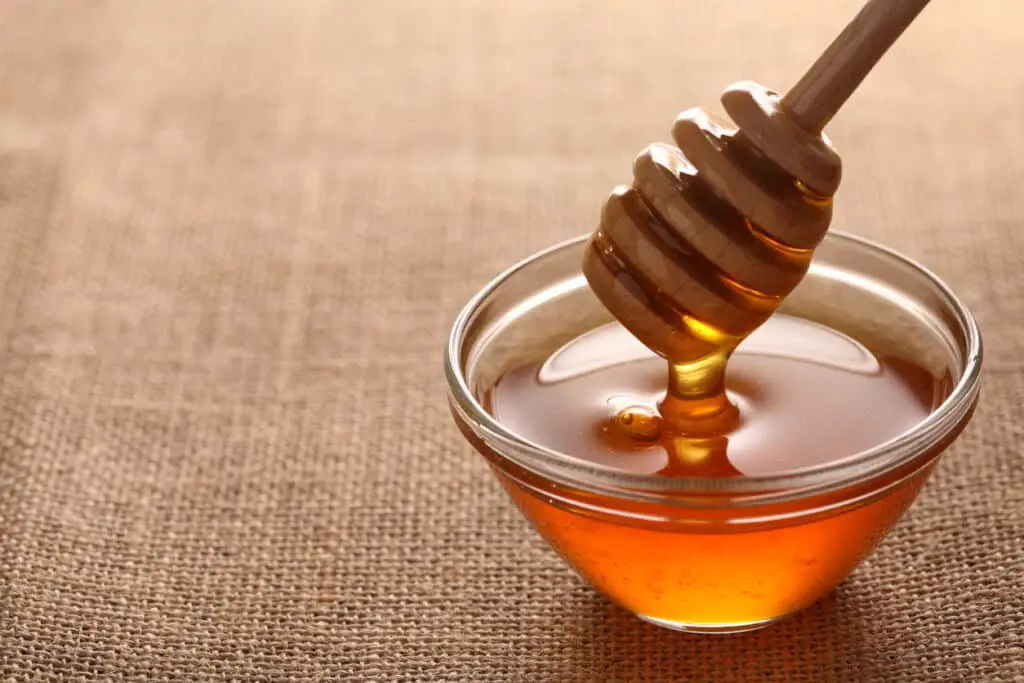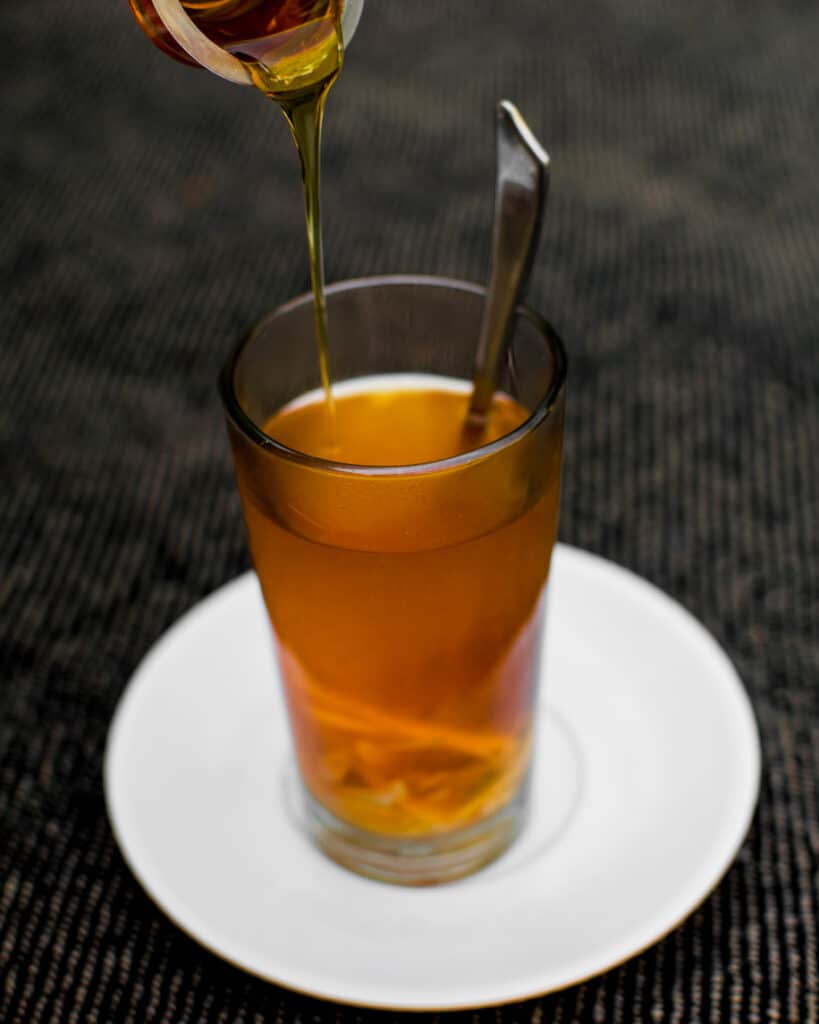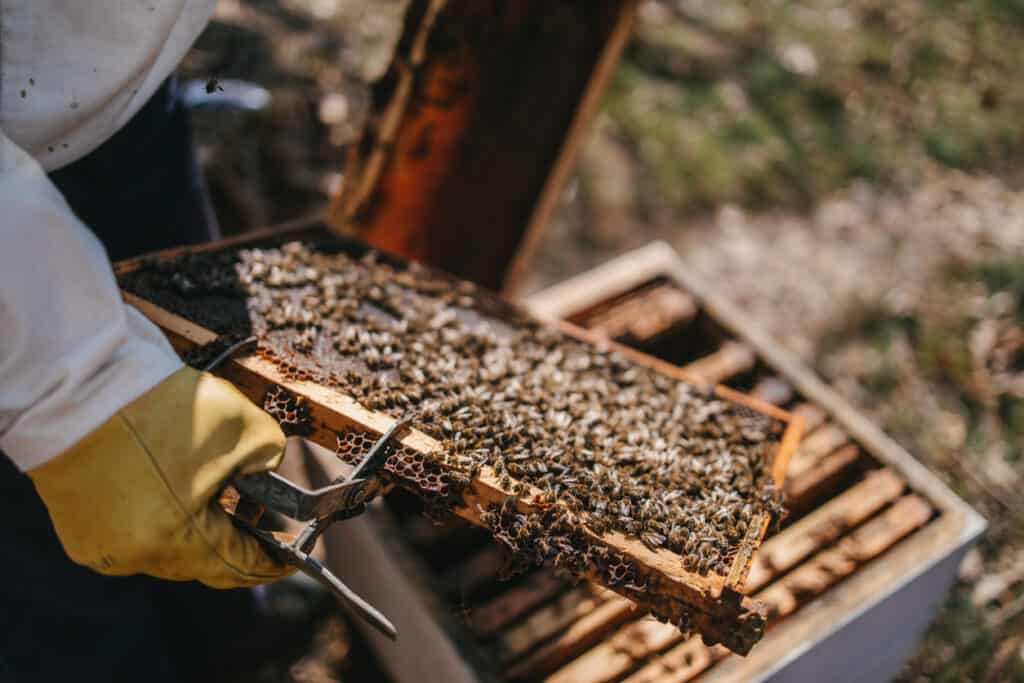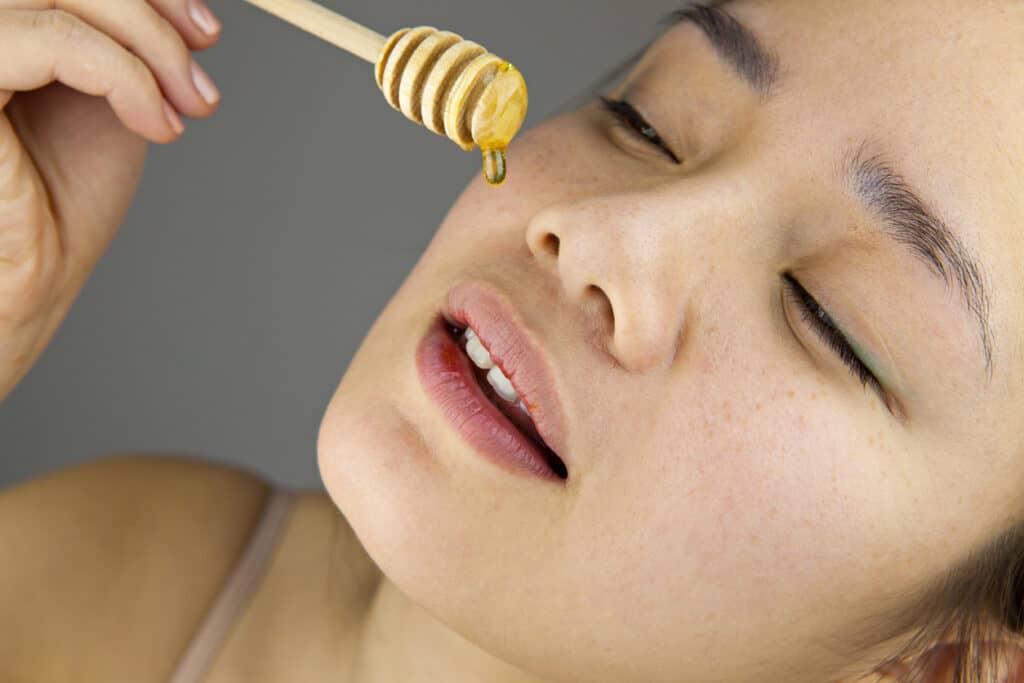Even small children understand the basics of honey: worker bees (always female) venture out of the hive where they collect pollen to make honey stored in honeycombs. The worker bees have a stinger, and if they use it, they die. However, the Melipona honey missed this “how to be a bee” memo. This is why Melipona honey is so unique.
Melipona honey originates from the Yucatán Peninsula in Mexico. The Mayans cultivated this honey for medicinal purposes. A variety of stingless bees make this honey, eschewing honeycombs. Instead, they store it in sack-like “pot” structures. The honey contains unusually high levels of antioxidants.
Melipona honey is rare and natural gem. Cultivating these unique pollinators requires a certain skill set, in addition to their particular climate and foliage needs. These stingless wonders cannot be raised like your average European honeybee. However, the art of keeping these extraordinary creatures is dying out along with their habitat. Yet to the bafflement of scientists, these bees are far from giving up.
Melipona Honey: The Stingless Bee Honey

Melipona honey comes from Melipona bees that originated in the Yucatan Peninsula. The Melipona is a stingless bee variety that bites, rather than stings, as their form of defense. The Melipona make homes in logs or hollowed-out trees. However, unlike your typical bee, they don’t make honeycombs and cannot be tempted to use a traditional beekeeper frame.
Instead, Melipona bees create sack-like nests inside their hive, often referred to as “pots.” The pots from an entire hive will produce 1-2 liters of honey. This is vastly smaller than your typical honeybee, which easily produces 70 liters per hive. However, while the Melipona bees lack quantity, they make up for it with quality.
The Melipona bees’ diminutive size allows them to access flowers that other bees are too big to use. These tiny workers feed on local plants that contain high levels of alkaloids and flavonoids. In addition to the highly nutritious flora is the Melipona bees’ exceptional levels of absorption and retain these plants’ valuable properties. Thus, the Melipona bee produces excellent, high-grade quality honey.
Due to Melipona’s scarcity and excellent quality, the honey is relatively expensive compared to what is found on a standard grocery store’s shelf. In addition, its valuable nature has led it to be primarily used medicinally, such as in making eye drops, rather than in culinary creations. Nonetheless, it can be eaten, and many find the taste delicious.
Where In The World Is Melipona Honey From?
Melipona honey originates in the Yucatán Peninsula in Mexico. The honey has been used for thousands of years by local people, starting with the Mayans.
How Is Melipona Honey Harvested And Extracted?
Melipona honey is extracted by breaking and crushing the pot structures, leaving them to drain. Traditionally, cultivators can harvest from their bees twice a year.
What Does Melipona Honey Taste Like
Melipona honey is high in fructose and lower in glucose, and has an acidic quality. This gives it a sweet-and-sour taste, with floral and citrus undertones. In addition, it has a runnier consistency than the average honey found in a supermarket, lessening the likelihood of crystallization. Thus, Melipona honey is often referred to as syrup rather than honey.
Its color ranges from nearly transparent to dark amber, depending on which native plants its colony favors. The Mayans would sometimes use it to make amber-like jewelry due to its beautiful tones.
How Do You Use Melipona Honey?

Due to the price of Melipona honey, it is primarily kept for medicinal use rather than culinary indulgence. That said, it is delicious, and some chefs will use it to top off some decadent desserts. For example, drizzle it over crepes that are dolloped with crème fraíche.
But in communities that raise Melipona bees, they will occasionally use the honey and combine it with a tree-derived blache to produce a special alcoholic beverage that resembles mead. This process requires a significant amount of honey. But it is possible to use Melipona honey in more modest amounts to add a unique twist to drinks.
For example, one excellent cocktail uses:
- Tequila
- Lemon juice
- Ginger
- Cointreau
- Melipona honey
Alternatively, it can be served as an after-dinner drink before guests depart:
- 1 shot of Mexican espresso
- 3 teaspoons of Melipona honey
- A modest dab of juice extracted from fresh ginger
Are Melipona Honey’s Stingless Bees Going Extinct?

Melipona bee numbers are rapidly dwindling in Mexico. Like many animals, much of this has to do with the loss of habitat. The Yucatan Peninsula has had an uptick in destructive storms, including hurricanes, that have had a devastating impact on forests. Logging and pesticide use in the area has also taken their toll.
However, another key factor to their reduction in numbers is the lack of stingless bee farmers. The majority of Melipona honey cultivators are older men in incredibly rural areas. It seems younger people are not continuing the practice; thus, the art of keeping these bees is being lost in communities.
There is also the matter of money. In commercial farming, stingless bees are a low-producing product. As mentioned higher up, a hive of Melipona bees produces 1-2 liters of honey, whereas a hive of European honeybees can produce an average of 70 liters. So even with Melipona honey sold at a higher price point, it doesn’t have a comparative commercial value.
However, with movements such as Slow Food and interest in heritage seeds and breeds, there is growing awareness that homogenizing our food and environment adversely impacts us all. Thus, there has been a small uptick in interest in keeping this bee and its valuable honey around.
However, the Melipona bee isn’t content to wait for people to wake up. Instead, the bees have taken matters into their own wings. Baffling scientists, a number of Melipona bees packed up and moved to another country. More puzzling, it wasn’t just across the border to Guatemala, Belize, or the Southern United States, but Cuba.
How Did Melipona Honey’s Stingless Bees In Cuba?
Scientists have yet to pinpoint how or even when Melipona bees ended up in Cuba. It is assumed they came by ship, but their exact origins remain a mystery. Not that Cuba is complaining. Cuba is a huge honey-producing country, and the locals have embraced the arrival of the Melipona bee. So much so, that Cuba now boasts the largest population of wild Melipona bees.
However, Melipona honey is not a major commercial product in Cuba. Instead, it is your everyday bee hobbyist that keeps them, extracting honey from the pots via syringe. People give it to friends and family, use it at home, and sell it to neighbors and local pharmacies. But Cuban enthusiasm for the bees and their honey may be what saves Melipona honey from being lost to history.
What Did Mayans Use Melipona Honey For?
The art of raising Melipona bees has been around since the Mayans. The honey was highly valued. Twice a year, a priest would preside over the honey harvest. It is believed that honey was used in religious practices, and beekeeping methods were said to be defined by the bee god Ah Mucen Kab. Some of these instructions have survived in the Madrid Codex.
In addition to the honey being used for religious purposes, it was used as a sweetener and as a valuable medicine.
Mayans believed that Melipona honey possessed a god-sent-healing force. Their doctors depended on it to make many of their treatments for a range of ailments. These include:
- Fevers
- Wounds
- Burns
- Stings
- Bites
- Respiratory issues
- Digestive ailments
Does Melipona Honey Have Health Benefits?
Science has found that honey has health benefits, and many studies have looked into the various uses of stingless bee honey. However, while honey, especially Melipona honey, does have positive health benefits, there are those that will position the honey with miraculous powers, exaggerating its abilities. Yet, the honey is far from worthless, proving particularly valuable in treating wounds and certain eye conditions.
Melipona Honey Used To Treat Wounds
Honey has a long history in wound healing, including by the Ancient Egyptians. Melipona’s value in treating wounds is due to having higher antioxidants and overall higher potency. Much of this is due to the stingless bees’ superior ability to absorb nutrition from the plants.
Honey has a few properties that help wounds heal. The first is its antimicrobial capabilities. Microorganisms in the wound can arrest or at least slow healing. But honey can act as a natural antibiotic, keeping an injury clean of unwanted bacteria.
Stingless bee honey, including Melipona, has been found to have a broader antimicrobial range than typical honey. In short, it can reduce the presence or eliminate a higher number of germs.
The second significant property in honey crucial to wound healing is antioxidants. “Oxidative stress” to tissues, especially those surrounding a wound, can slow wound healing or cause complications. Thus, the antioxidants in honey help protect the tissues, allowing them to do their valuable job. As stingless bee honey, including Melipona, are higher in antioxidants, they offer greater protection to wounds from this stress.
A third honey benefit to wounds is honey’s anti-inflammatory properties. Inflammation can slow healing. However, many anti-inflammatories have side effects that honey does not possess, making them less beneficial. Thus, due to honey’s anti-inflammatory properties having reduced to no side effects, it is thought to produce less scarring.
Lastly, honey is a moisturizer, as is its wax and jelly. Keeping a wound moist helps prevent other infections, reduces pain, reduces scarring, and helps keep blood circulating. Part of honey’s moisturizing benefits is down to its vitamins B, E, and K levels.
Melipona Honey Used To Treat Eye Conditions
Melipona honey has been used to treat various eye conditions. Studies have shown that it can be an effective treatment for conjunctivitis. Studies have also confirmed that it can be safe to use it, provided the honey has not been contaminated by any other substance.
Some people promote Melipona honey as a cure for cataracts and glaucoma. Unfortunately, science has yet to produce evidence of such claims. However, that doesn’t mean the honey is worthless as a treatment. For example, there is evidence of it reducing the progress of selenite induced cataracts. This is valuable for people with a lack of access to proper medical care.
Melipona’s moisturizing properties have also made it useful as a basic eye drop for dry eyes. The product can easily be obtained off Amazon, although many Melipona cultivators simply dab the honey directly into their eyes. However, the safety of the latter method is unclear.
Melipona Honey As An Acne Treatment

Melipona honey has been used as an all-natural acne treatment. It is valued for the same reasons it helps wound healing. The antimicrobial properties combat bacteria in the skin, the antioxidants bring nourishment, and unlike many acne treatments, it moisturizes rather than dry out the face.
As Melipona honey is expensive and highly concentrated, masks are made by combining it with other natural ingredients. Popular additions include:
- Oatmeal
- Cinnamon
- Lemon
Lemon, however, does have a drying effect. Since Melipona honey already has an acidic nature, this can be too much for sensitive skins. Thus, for those wishing to try it, perhaps try oatmeal first, a gentle combination.
Alternatively, the honey can be used as a spot treatment. While this has had beneficial results for many people, users admit that it can be “runny” and challenging to use. Hence, more people prefer to use a mask that is washed off after 20 minutes than as a spot treatment.
It is also thought that the same properties that reduce scarring in wounds help reduce marks left by acne.
Melipona Honey Relieves Sore Throats
Honey is a common treatment for sore throats and coughs. Melipona, being all the more protenant, is thought to bring even greater results. It may not cure a person’s infection, but it is an excellent all-natural alternative to over-the-counter cough syrups and lozenges. Drink a spoonful in hot water with a squeeze of lemon and some ginger for maximum relief.
Melipona Honey Is A Good Hair Treatment
Much has already been known about honey being beneficial to hair. However, with Melipona being higher quality honey, its positive impact on your scalp and hair follicles is all the more. The preferred method for using it is creating a hair mask.
Making a honey mask can be as simple as combining honey with olive oil, coating your hair and scalp, then covering your head with plastic wrap or a shower cap. Then, wait for half an hour before washing it out.
Potential benefits of a Melipona hair mask include:
- Frizz control
- Reduces dry scalp
- Moisturizes and conditions hair
- Shine booster
- Hair softener
Melipona Honey Is A Good Sweetener For Weight Management
For those looking for a natural sweetener to use while managing their weight, a good choice is stingless bee honey, including Melipona. While it is far from calorie-free, a little goes a long way, and it is rated low in the glycemic index. It is also thought to have properties that help regulate appetite.
Melipona Honey May Reduce Cholesterol Levels
Stingless bee honey, including Melipona honey, is a good source of Fluvastatin, antioxidants, flavonoids, and fiber. Fluvastatin is a known “bad” cholesterol-lowering statin that reduces the liver’s production. However, how much Melipona honey you’d have to consume to have a noticeable impact is unclear.
Melipona Honey May Help New Mothers
One popular custom with Melipona honey is still practiced by locals today: giving new mothers Melipona honey. The belief was that the honey’s nutrition, energy boost, and medicinal properties would aid the mother’s recovery.
Melipona Honey May Help Digestive Problems And Ulcers
Melipona honey has a long history of being used to treat digestive complaints, including ulcers. It is considered soothing while reducing inflammation of the gut. Research has been done using Kelulut honey, another stingless bee variety. The results were incredibly promising.
Melipona Honey May Reduce Tooth Pain
Melipona honey may help reduce oral aches and pains when other treatments are unavailable. In addition, the honey’s properties help rid the area of bacteria and fungus while reducing inflammation. Thus, while it is not a numbing agent, it could bring relief by combating the infection and reducing the swelling.
Melipona Honey May Reduce Cancer Risk
Melipona honey contains cytotoxic properties, which are helpful in treating cancer. These properties combined with flavonoids, polyphenols, anti-angiogenic properties, anti-proliferation properties, and anti-inflammatory properties all create the possibility of the honey reducing the risk of cancer in those who ingest it. However, it is unclear how much Melipona honey would have to be consumed on a daily basis to have a significant impact on risk percentages.
Melipona Honey May Have Anti-Diabetic Properties
Honey isn’t thought to be the food of choice for diabetics. However, there have been promising pre-clinical trials into the positive benefits. However, the few clinical trials have had less success. There is a hypothesis that the quality of the studies may be at fault for the discrepancy, but for now, the science on it remains uncertain.
Are There Other Stingless Honey Bees Besides Melipona?
Melipona bees are only one of around 500 species of stingless bees. The species fall into two main genera: Melipona and Trigona.
The Melipona genus contains 70 species, most of which are found in Central America and the upper areas of South America, such as Northern Brazil. One of the biggest exceptions is Argentina.
The Trigona genus with over 80 species. Their range starts at the top of Mexico and ends in the northern part of South America. Its honey is considered pretty sour and watery. They are also considered to have a fairly aggressive nature.
Australia also has stingless bees once classified as Trigona but now Tetragonula. There are eleven species on the continent. They are found in the tropical parts of Australia, ranging from the East up to the northern rim, avoiding the West and Southern Coasts and the central interior.
Southern Asia also has many species of stingless bees. Many of these are in the genus Tetragonula.
Africa has about 22 species, falling under the genus Meliponula Cockernell.
Are There Stingless Bee Honeys As Tasty As Melipona?
Many stingless bee honey varieties can be incredibly sour and “bushy” in flavor. However, they are known to have many of the same beneficial medical properties that make Melipona so valuable. But in the over 500 species of stingless bees, there are some other kinds of honey that are both tasty and medicinal.
Kelulut: Stingless Bee Honey
Kelulut honey is a popular “superfood” in Malaysia. It is believed to have around ten times the antioxidants of your standard grocery store honey. Like Melipona, it is also has a broad spectrum of medicinal properties such as antibiotic, antifungal, and anti-inflammatory while being a good source of flavonoids and phenolic acids.
Arusha Honey: Stingless Bee Honey
Arusha honey, called nyori by locals, is from Tanzania. Their stingless bee produces 3-4 liters of honey but is typically only harvested once a year in January-February. It has that stingless bee tang of sweet and sour, with citrusy undertones. It is also a fairly liquid consistency. The bees are fairly big and are primarily black.
Sugarbag Honey: Stingless Bee Honey
Sugarbag honey is Australia’s generic name for honey that comes from one of their eleven stingless bees. As it isn’t specific to the bee or region, so the taste can vary between where a jar was sourced. However, they are all thought to be medicinally beneficial. Like the Melipona bees, the output is tiny compared to commercial honey bees. However, a small market is emerging.
The sugarbag honeys generally have a sweet-sour flavor. The ones found on the coast tend to have more of a citrus tang, whereas the ones further inland tend to have a taste closer to regular honey.
Is Manuka Honey From Stingless Bees?
Manuka honey is incredibly popular in New Zealand and Australia and has been ranked highly in quality and health benefits. Thus, many have assumed Manuka honey is made by a stingless bee, but this is not true. Manuka bees do sting, and they store their honey in the traditional comb configuration rather than the pots.
Conclusion
“Superfoods” is a marketing term banter around with little scientific evidence to back it up. Nonetheless, if there were an award for such a thing, Melipona honey would be a favorite to win. Not only is the honey absolutely delicious, but it is also has been helping people medically for thousands of years. These small, stingless bees may take their time producing honey, but it is worth the wait.

